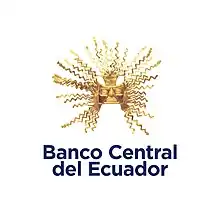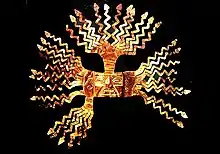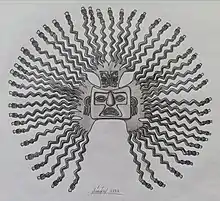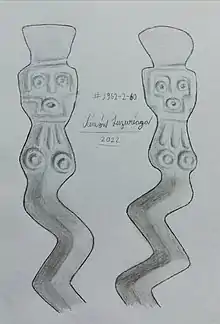| Golden sun of La Tolita | |
|---|---|
 Golden sun represented in the Logo of the Central Bank of Ecuador. | |
| Material | Gold |
| Weight | 246 gr |
| Discovered | 1939 or 1940 |
| Present location | Casa de la Cultura Ecuatoriana, Quito, Ecuador |
| Culture | Tumaco-La Tolita |
The Golden sun of La Tolita, Golden sun of the Central Bank of Ecuador, Golden sun of Konanz, Golden sun of Quito' or simply Golden sun, is an archaeological artifact in the form of a mask or a headdress that represents the sun with a face. The Central Bank of Ecuador adopted this sun as its logo.
Usually, the provenance of this piece is attributed to the Tumaco-La Tolita archaeological culture that inhabited the northern Ecuadorian coast and the southern Colombian coast. Despite this, there are doubts about the true provenance of the Golden sun. There is another very similar archaeological piece also known, the so-called Golden sun Guayaquil or Golden sun of Estrada, although there are doubts about the authenticity of this second part.[1][2]
History
The Golden sun of the Central Bank was acquired by collector Max Konanz in 1940, who bought it from Cornelio Vintimilla Muñoz, a merchant from the city of Cuenca, who in turn bought it from Mr. Ariolfo Vásquez Moreira. The information given by the seller indicates that the mask would have been found in 1939 or 1940 in a town called Chunucari, between the towns Chordeleg and Sígsig, in the Azuay Province, Ecuador. This area is known for its very rich burials. Unfortunately, this information is not reliable, since the piece was found by looters, who tend to lie about the provenience of archaeological finds because of possible legal implications or to maintain secret the location of sites containing valuable artifacts. Despite this, Mr. Konanz accepted the origin indicated by the seller.[1]

The piece was folded into a ball when Konanz acquired it. It was probably folded by the looters who found it to facilitate its transport. The collector, along with his wife Dolores Vintimilla, unfolded the piece, but several sun rays broke on the spot.[1]
Casa de la Cultura Ecuatoriana (The Ecuadorian House of Culture) published a picture of the golden sun in a 1953 bulletin.[3] Shortly after, in the mid-1950s, archaeologist Emilio Estrada acquired the second golden sun in the Manabí Province.[2] This new sun raised suspicions of it being a fake because of some typological inconsistencies and the closeness of its find to the publication date of the Golden sun of La Tolita.[1]
In 1960, the Central Bank of Ecuador bought Max Konanz's collection and adopted the Golden sun as its logo. At that time, the origin indicated by Mr. Vásquez Moreira was questioned. Through typological analysis, it was concluded that the origin of the piece must be the Tolita culture of the Ecuadorian Coast.[1] In 1978, the Central Bank also bought the Golden sun of Estrada.[2]
The change in the provenance of the piece from Chunucari to La Tolita was the cause of many discussions, for this reason, the Central Bank carried out chemical studies in both Golden suns in 2001 and 2002. The aim of these studies was to determine the place of origin of the metal with which the objects were made. They concluded that both suns come from the north coast of Ecuador, the place inhabited by the Tolita Culture.[2]
In 2018, a controversy broke out on social media because an accusation was made of the possible theft of the piece. For this reason, new chemical analyzes were carried out that confirmed that the piece was the original, since these studies yielded results very similar to those carried out between 2001 and 2002.[4]
Decoration

Both suns have a rectangular face from which zigzaging sun rays are born. The rays are clustered into five groups. These go to the left, right, up, down and left, and down and right, but neither goes down from the centre. Throughout the entire piece there are relief decorations achieved using the embossing.[2]
Face

Both suns have a rectangular face, inside which there is a T-shaped section where the eyes, nose and mouth are located. The eyes and the nose have a similar shape on both suns, but in the mouth is a little different. While both headdresses have a slightly downward-twisted mouth, the one on the Golden sun of La Tolita has four fangs that do not exist on the Golden sun of Estrada.[1]
Ears
In the Golden sun of La Tolita, the ears are two concentric semicircles from which three lines are born that presumably represent earrings. There is a hole in the center of the semicircles that presumably would serve to attach it to its mounting.[1]

On the other hand, in the Golden sun of Estrada, the ears consist of a double spiral placed backwards. The holes are between them and the face . Although this type of ears has been seen in other Andean cultures, they are usually looking to another direction. This typological inconsistency was pointed out by archaeologist Karen Olsen Bruhns to suggest the possibility that this piece is fake.[1]
Crested Animal
At the base of the upper cluster of rays is a two-headed crested animal. This exists exclusively in the golden sun of La Tolita, while in the golden sun of Estrada this area is empty. The animal is very similar to the Animal of the Moon of the Moche culture.[1] The art historian Costanza Di Capua pointed out the existence of very similar figures in other pieces of La Tolita to argue that this culture was the origin place of the golden sun.[5]
Sun rays
The rays of both suns are in pairs. They are an example of what archaeologist John H. Rowe called "Kennings". These are an artistic element of South American prehistory that consists of turning the long and thin appendages of any piece into snakes.[1]
The Golden sun of La Tolita has 48 symmetrically located rays. Most of them are broken, only 12 are complete. A raised line runs through the center of each ray. The serpent heads in this piece hold in their mouths another head called "Trophy Head", which has a face in the same T-shape as the central face. These heads have a tall headdress. Very similar heads can be seen in other pieces from Tumaco-La Tolita culture, which supports the argument that this culture is the true origin of the headdress.[1][5]

Chemical composition
In order to know whether the origin of the Golden sun is the one indicated by Mr. Ariolfo Vásquez (the province of Azuay) or if it comes from the Ecuadorian or Colombian coast, the Central Bank ordered physical-chemical analyzes to be carried out on the two golden suns and several samples from pre-Columbian goldsmith pieces from Ecuador. It was concluded that the gold with which the pieces were made is more similar the pieces from the Ecuadorian Coast than to the pieces from Azuay, suggesting that the origin is Tumaco-La Tolita.[2]
In addition, it was found that both Golden suns have a very similar chemical composition. This led to the hypothesis that they were made in the same workshop, which contradicts the supposed forgery of the Golden sun of Estrada.[2] Although the chemical resemblance could be explained because local jewelers usually use gold of archaeological origin, therefore that it cannot be affirmed that the Estrada sun is original.[6]
A second chemical composition study was carried out in 2018 in order to verify the authenticity of the Konanz Sun due to rumors that it had been stolen.[4] These studies were able to demonstrate that the piece is authentic in addition to showing that the composition of the sol is not homogeneous.[7]
| Sample | Gold | Silver | Copper | Platinum | Palladium | Arsenic | Titanium | Ruthenium | Tin | Antimony | Tellurium | Lead |
|---|---|---|---|---|---|---|---|---|---|---|---|---|
| Golden sun of La Tolita | 79.8% | 9.7% | 9.5% | 0.930 ppm | 95.0 ppm | 8.0 ppm | 1.0 ppm | 45.0 ppm | 4.0 ppm | 2.0 ppm | 3.0 ppm | 30.0 ppm |
| Golden sun of Estrada | 81.8% | 11.4% | 5.5% | 1.170 ppm | 63.0 ppm | 8.0 ppm | 1.0 ppm | 63.0 ppm | 1.0 ppm | 4.0 ppm | 2.0 ppm | 3.0 ppm |
| Gold | Cooper | Silver | Platinum | Palladium | |
|---|---|---|---|---|---|
| Average percentage | 83.39% | 10.68% | 2.99% | 1.81% | 0% |
Manufacture
The manufacturing process for the Gold Sun would have required heating the gold up to 990 °C in a furnace and then pouring it in a mold. After which the piece would have been continuously hammered and reheated until a fine sheet of gold was obtained. The nose was achieved using the deep drawing technique, while the other face decorations were achieved by embossing. After making the face, they would have continued to cut parts of the sheet to form the rays, the deformations caused by the cutting process would have been corrected by hammering.[7]
References
- 1 2 3 4 5 6 7 8 9 10 11 Olsen Bruhns, Karen (1988). "Huaquería, procedencia, y fantasía: los soles de oro del Ecuador" (PDF). Boletín del Museo del Oro (in Spanish). No. 44-45, Enero–Diciembre.
- 1 2 3 4 5 6 7 8 BARRANDÓN, Jean Noël; VALDÉZ, Francisco; ESTÉVEZ, Patricia (2004). "Identificación mineralogica de las Fuentes del oro precolombino utilizado en la metalurgia prehispánica del Ecuador" (PDF). Anejos de AEspA XXXII (in Spanish).
- ↑ Aráuz, Julio (1953). "Front Page" (PDF). Boletin de Informaciones Cientificas Nacionales. VI (58).
- 1 2 "El Sol de Oro de La Tolita es verdadero". Últimas Noticias. 20 April 2018. Retrieved 5 April 2023.
- 1 2 Di Capua, Costanza (2002). DE LA IMAGEN AL ICONOEstudios de Arqueología e historia del Ecuador (PDF) (in Spanish). Quito, Ecuador: Producciones digitales Abya-Yala. pp. 277–298. ISBN 9978-22-287-1.
- ↑ Bruhns, Karen O.; Kelker, Nancy L. (2016). "The Golden Sun Of Guayaquil: A True Copycat". Faking the Ancient Andes. New York: Taylor & Francis.
- 1 2 3 Espinoza, Fernando; Romero-Bastidas, Martha (21 August 2020). "Sol de Oro". PAQU. (in Spanish). Instituto Nacional del Patrimonio Cultural. Retrieved 5 April 2023.